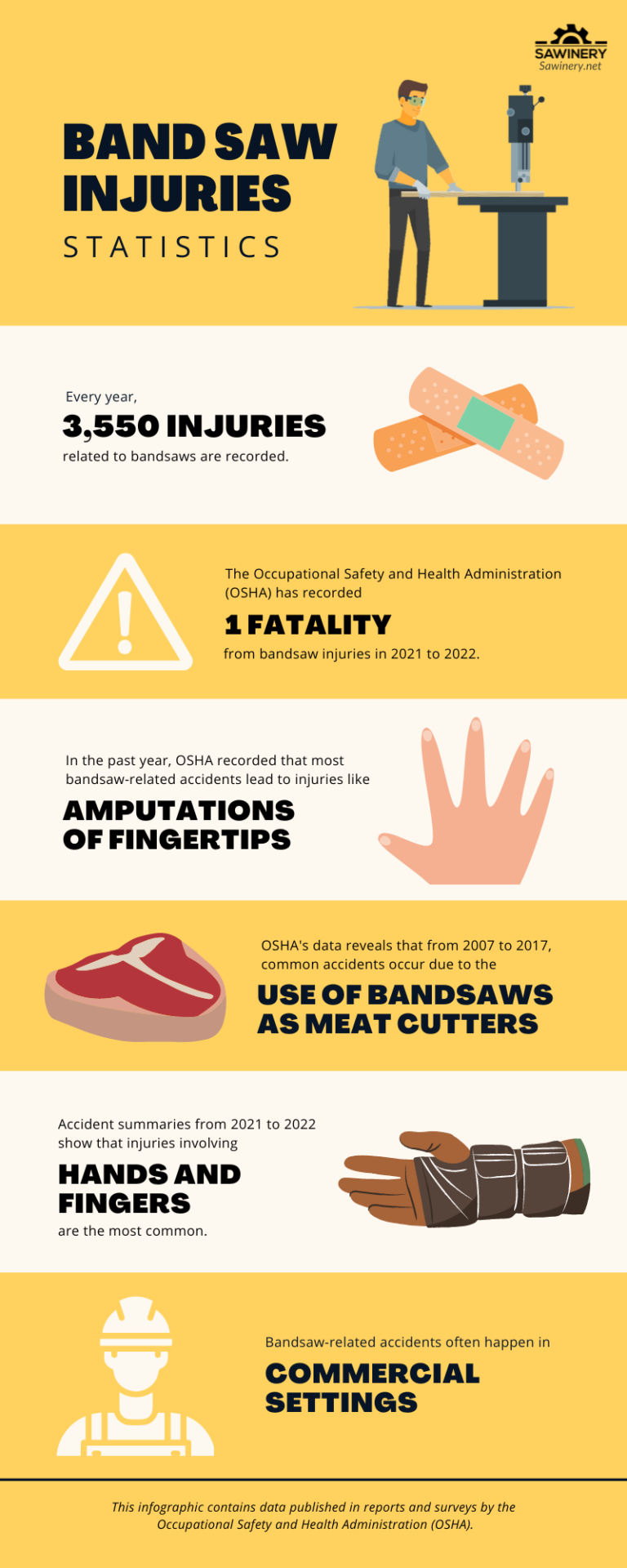Band Saw
Subject: Construction
Objective: Students will understand the foundational theory and applied concepts surrounding the safe use of the band saw. These standards are to be cross-referenced with the OCTE Standards linked here, and confirmed with the documentation which is printed in the administration kept in the classroom itself. No student should operate any equipment without adhering to the standard operating procedures, shop safety rules, and all work, setup, maintenance, and other such shop activities must be done with the express foreknowledge and approval of the appropriate respective workshop teacher under supervision and during shop hours.
FOR OFFICIAL STANDARDS OF REFERENCE PLEASE LOOK TO THIS LINK BEFORE CONTINUING
Nothing here is intended to take precedence over the directions set out in the manufacturer’s instructions, nor those safety set out by any ministry of education, ministry of labour, educational board, or legislative body. This is purely an amalgamation of resources to support education, but is not intended to be a definitive source for safety or procedure. For your own safety, refer to your respective legislation and overarching bodies regulating standards to ensure that you are following procedures which reflect the most recent and supported bodies of research.
Intro
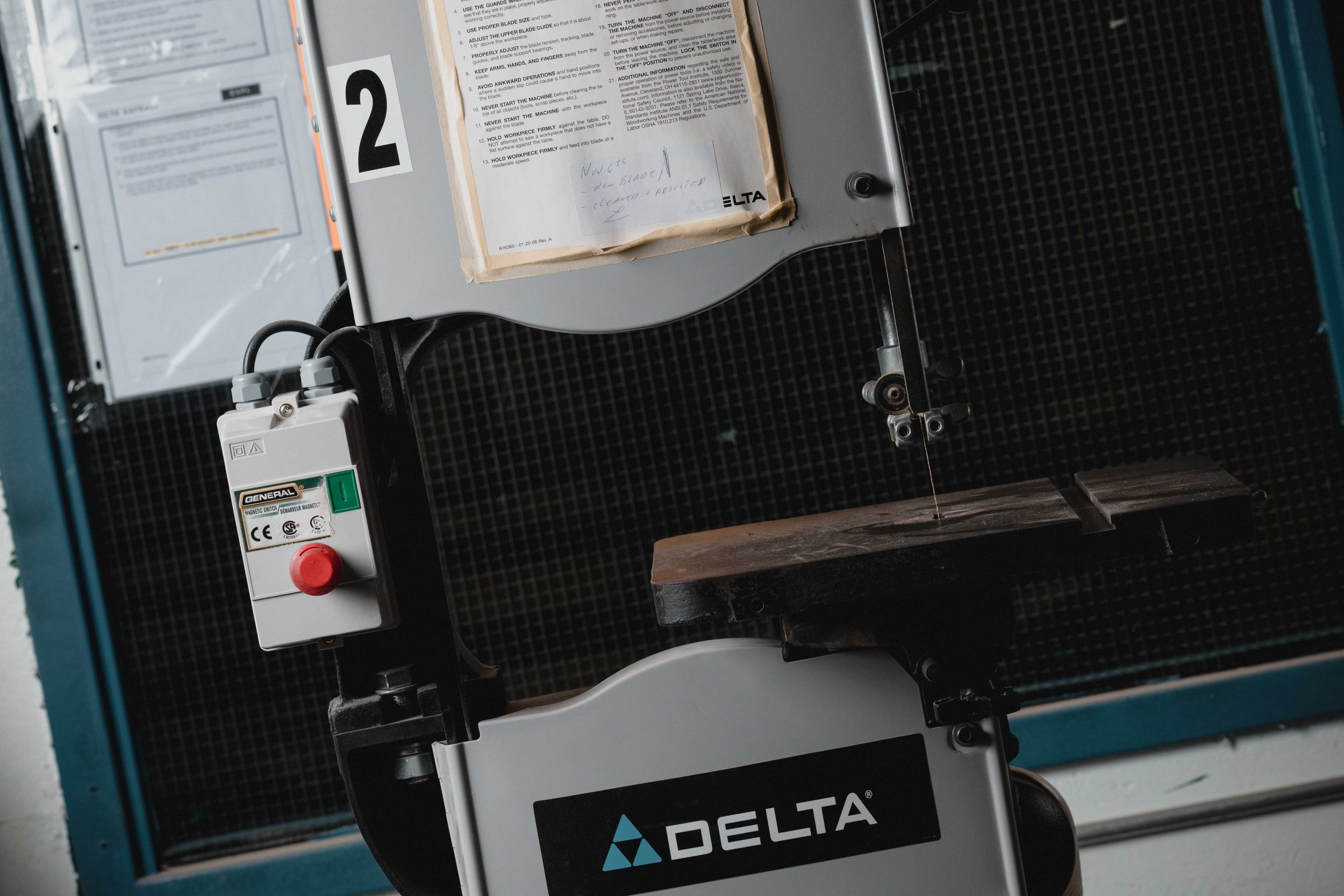
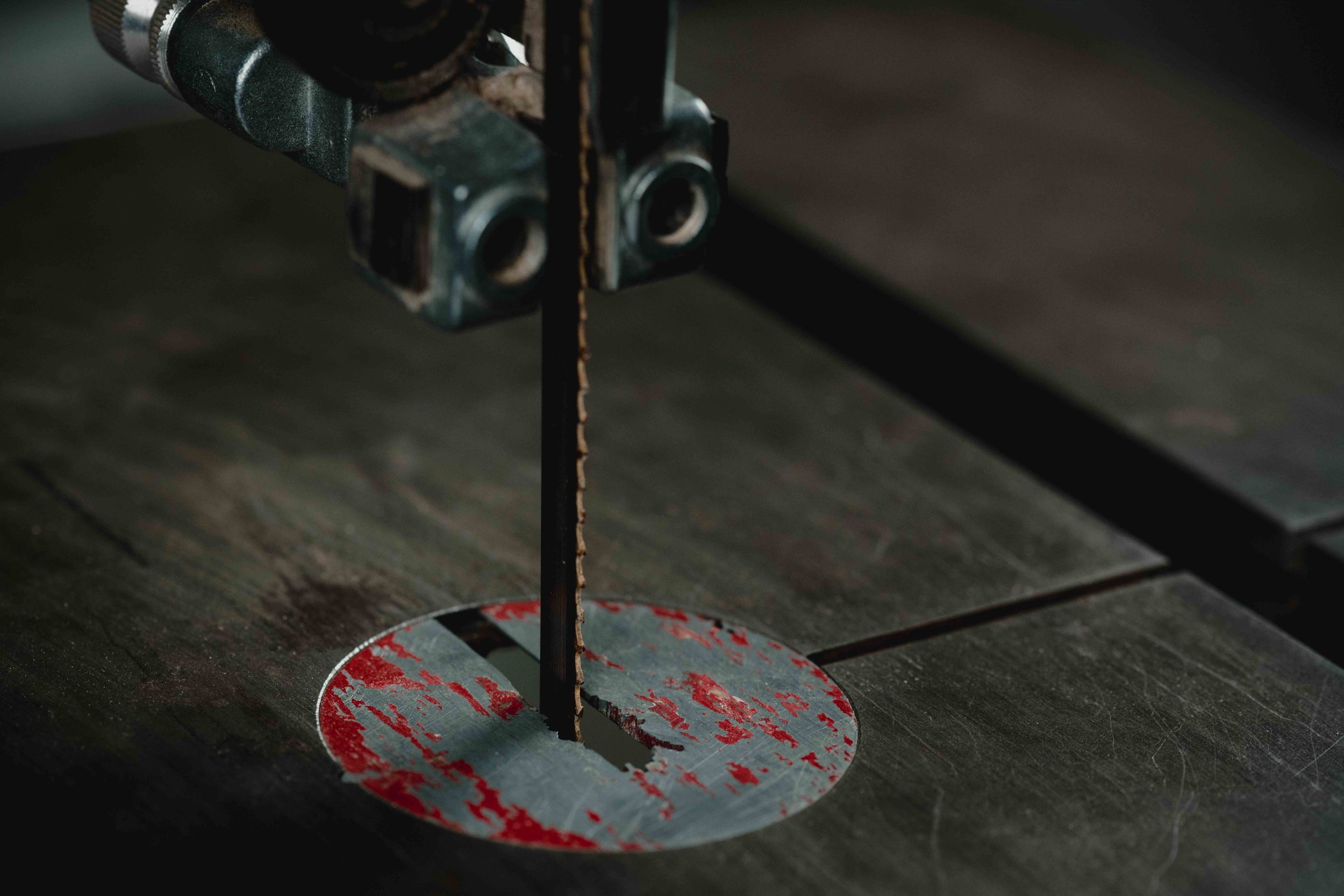

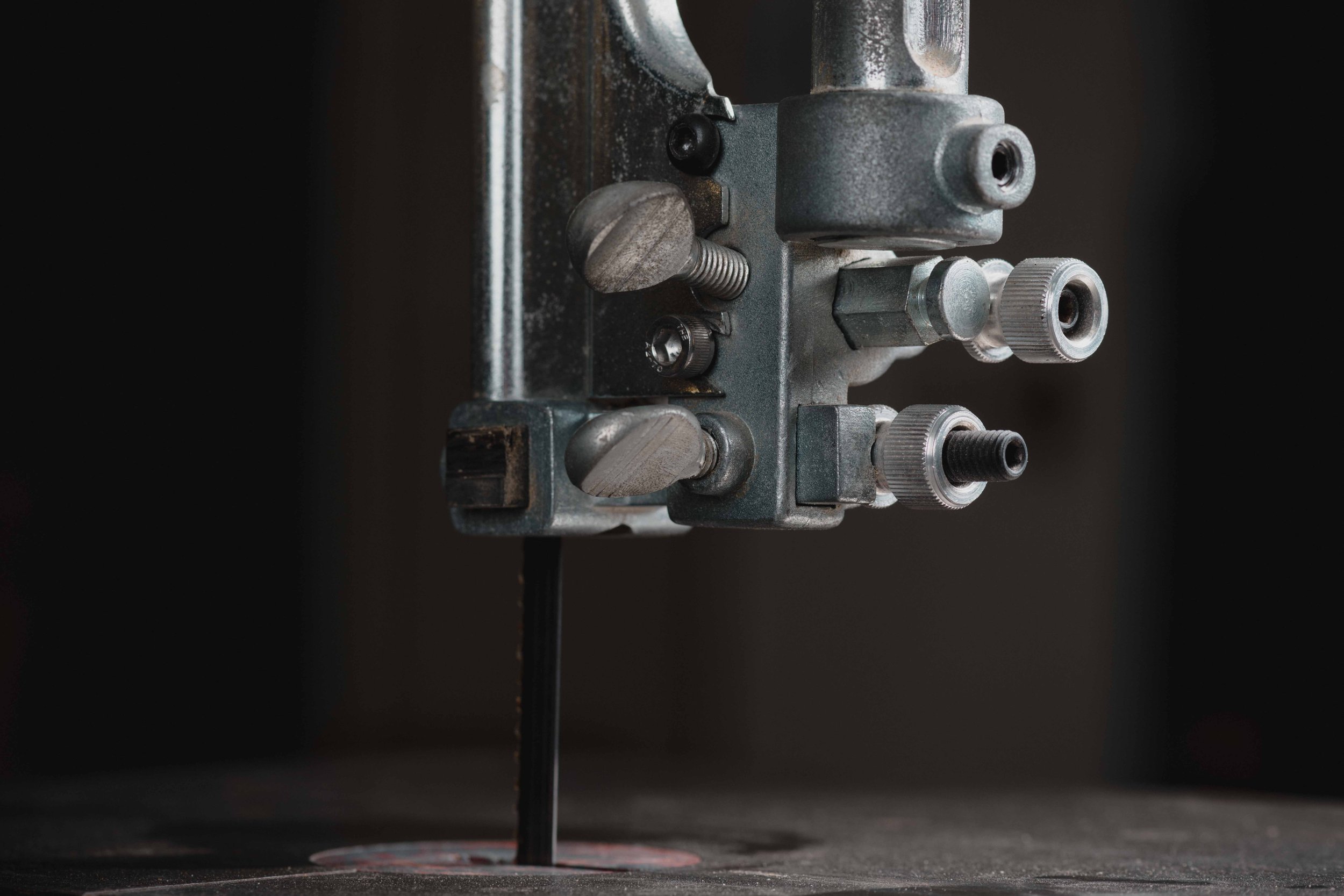
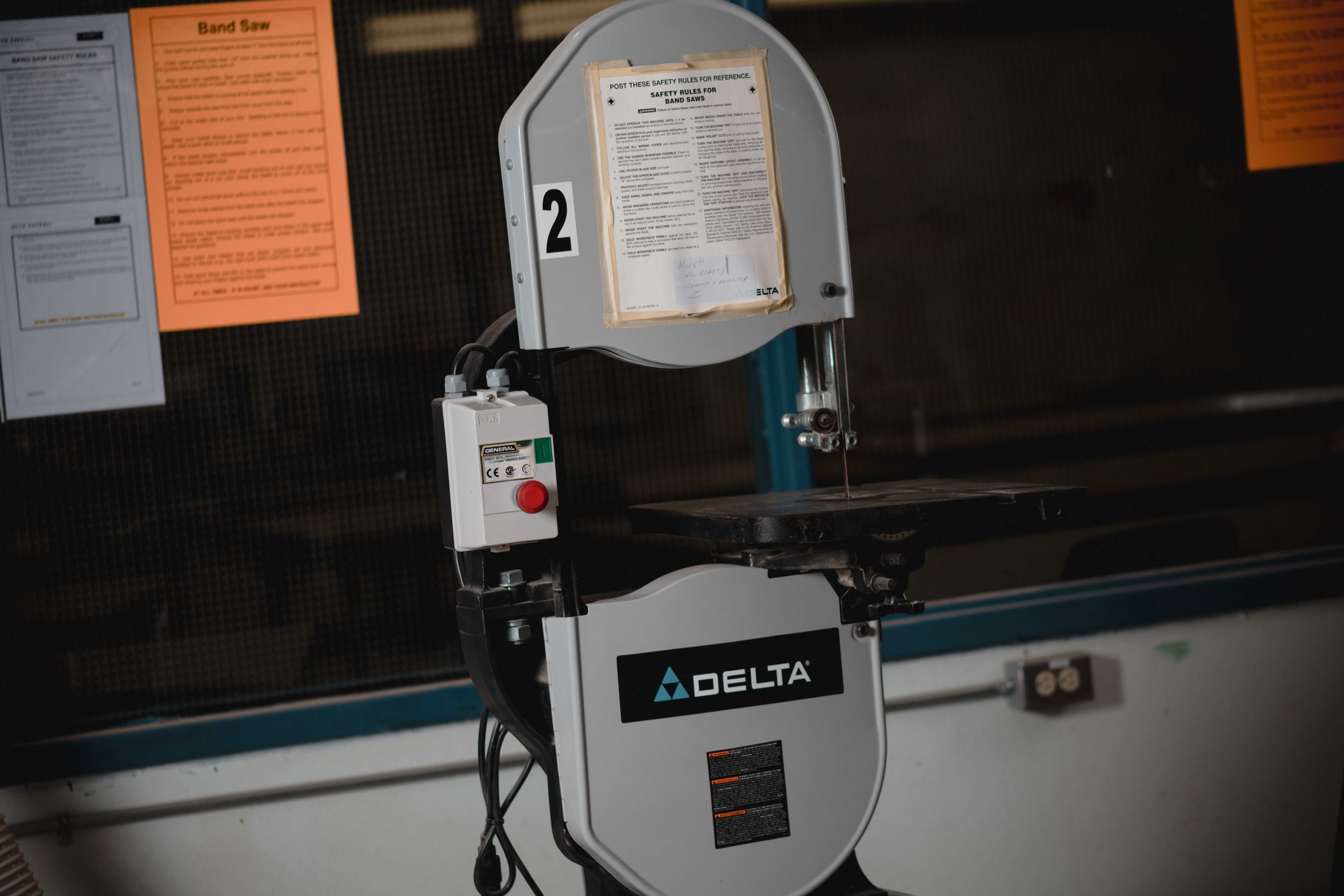
A bandsaw is a belt driven band-bladed tool which utilizes a two-wheel system in an enclosed cabinet housing to provide continuous downward cutting pressure as it spins. Generally this tool tends to be used for rip cuts as opposed to tools like a mitre saw, however accessories enable more complex cuts or even designs, as do techniques such as using relief cuts. An important design element is the tension of the wheels which enable the blade to be held firmly while in operation. Where tools like a table saw or a compound mitre saw can have angles of entry relative to their saw arm pivot points, or considerations such as blade bevel, material height, etc., the band saw has a constantly downward pressure.
The use of a system of guide bearings enables it to stay completely vertical through the cut, and to make sure that the cut is as taut in blade tension as possible, you need to bring the guard down to as close (with adequate clearance) to the work piece as possible. This makes jobs with a fence particularly tricky in that any push or give in the blade tends towards the right most often and the fence needs to be adjusted to account for that. Tools like gauge miter inserts can enable angular cross cuts. Thankfully the design is such that because of the constant downward cut pressure there are almost no chances of a kickback.
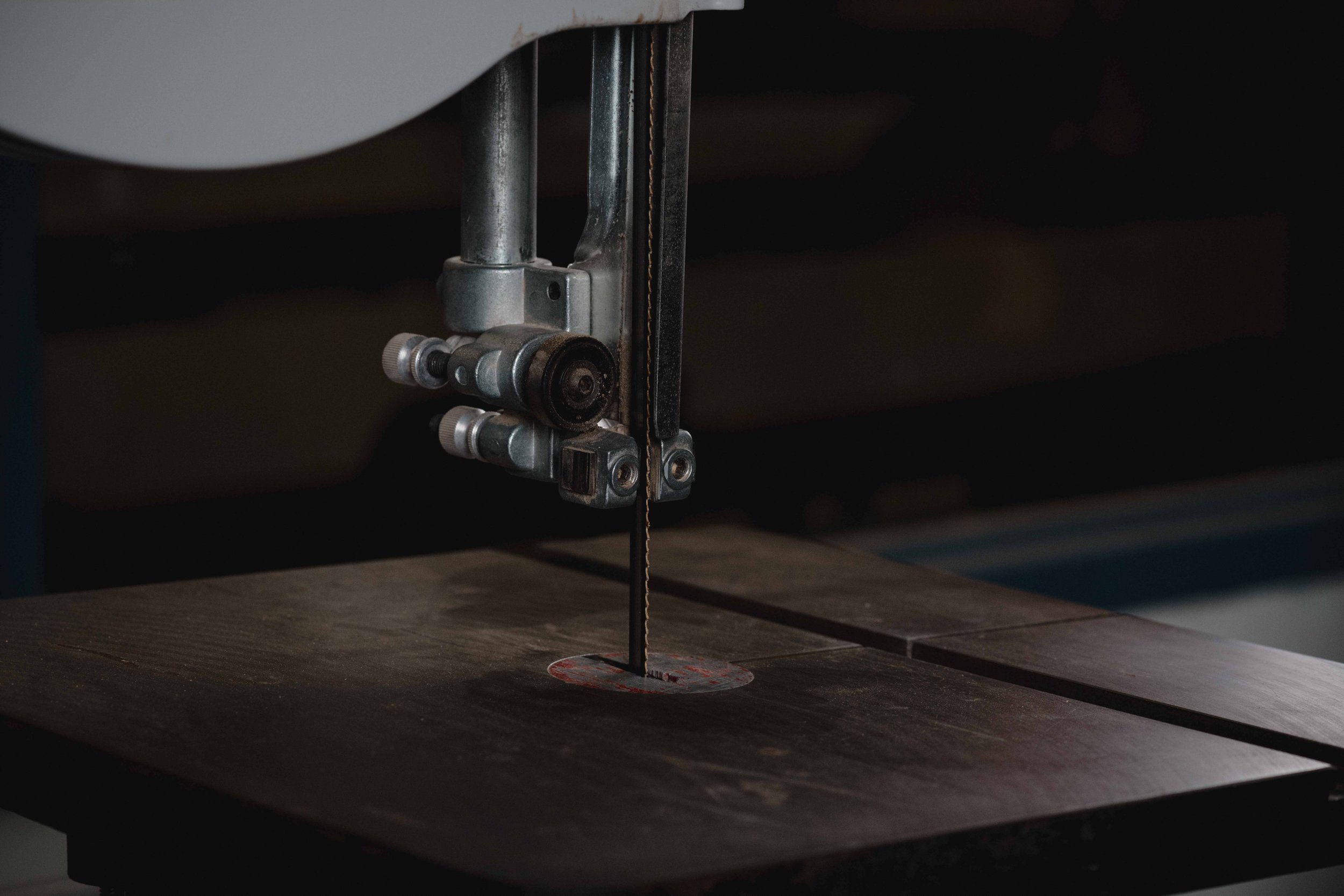


When you have selected the material and inspected it for things like knots, cracks, foreign elements like screws/nails/staples/rocks, decide upon where you want your cut(s) to be and indicate them clearly. Remember, much like any bladed chop machine this tool will have blade kerf, so do not cut directly on the lines you’ve indicated; Instead, you should determine which side will be considered waste, and make your cut to that side of the line with room to adjust back to the line once you are certain it is not cutting into the final project material. Before initiating your cut be sure that you have your PPE (protective glasses and ear protection) on, that you are not wearing jewelry, that your hair and clothes are appropriately tied back if necessary, and that the material is not in direct contact with the blade.
Be sure that you do not start the machine with the blade against any materials you’re cutting; though, as mentioned earlier, kickback is incredibly unlikely, the blade is intended to achieve operating speed before you start to feed the material along its path. Ensure that the guard is set to be about 1/4” above the material before you start working to ensure that it is optimal. ALSO, KEEP IN MIND THAT BELOW THE TABLE THE BLADE IS EXPOSED AND OFTEN UNGUARDED, DO NOT REACH BELOW THE TABLE AT ANY POINT WHILE THE TOOL IS OPERATING. Keep fingers back a minimum of 3” from the blade during the feed process, and at NO point should you reach behind the blade as it is an unsafe practice for any of our shop tools. When you are done with your project - or should there be any technical issue, stop the machine with the magnetic switch and do not walk away from the tool until such time as the blade is completely stopped (which given the inertia of the wheels can take up to half a minute). Once the tool’s blade is completely stopped then you can proceed to remove the material and off cuts and clear the surface of the table with a push stick or brush. Remember, the standard procedure is to drop the guard flat to the table when you’re done working on the tool, this will not only cover some of the exposed blade, but it also reminds the next operator to adjust it properly so that they use the tool correctly.
BAND Saw Safety
Beyond guides and fences, one can look to change things like the size and type of blade to accommodate different radius of cut needed. Understanding how to use and adjust the tool not only keeps us safe as operators, but it also enables us in safely making the tool more versatile - but do it within the scope of your qualifications; only the instructor and board-approved technicians are to adjust any elements other than the blade guard itself. Please feel free to watch these videos for techniques or ideas, but realize that many of the elements demonstrated do not reflect things we will explore in our classes - nor will you be qualified to attempt them even with a student safety passport. Do not attempt to modify our saw or use any techniques displayed without first securing express permission from your instructor.
Examples of Band Saw safety tips as demonstrated by Acutabove Woodworking. This is not an OCTE video, please do not use or attempt anything we do not instruct in class.
Unlike scroll saws, band saws can present an incredible risk if general safety operating procedures are not followed exactly. Nothing in this or any of the materials on this page is intended to replace the manufacturer’s instructions. This video is a bit older, and explores features and operating procedures which do not always follow what we have set out in our instruction - DO NOT USE THIS VIDEO AS AN INSTRUCTION IN PROCEDURE, REFER TO YOUR INSTRUCTOR’S DIRECTION AND LESSON DEVELOPED OCTE-APPROVED MATERIALS FOR ALL PROCEDURAL PROCESSES! Take a look at the video here exclusively to consider the safety concepts and to see demonstrations as to why we follow the procedures we do, as it showcases the risks of many mistakes in form or approach. If in doubt of anything at any time, stop working, safely shut off the machine, and ask your instructor.
A Band Saw safety video developed by the WoodWorkers Guild of America. Though they do not use the same model we have in our shop, nor follow the same operational procedures, the safety concepts are universally applicable.
Supporting Resources
Tool Specific:
OCTE Band Saw Overview
OCTE Band Saw Safety
OCTE Band Saw Rules
OCTE Band Saw Procedures
Broader Supporting Resources:
OCTE Health and Safety
OCTE SAFEdocs
OCTE toolSAFE
All supporting resources and much of the content are drawn directly from guidelines, standards, and materials on the OCTE pages; they are simply linked here for learner reference, and ease of instruction, however neither this page, nor the other materials represent OCTE. The other resources such as YouTube links, are included for learner refreshers.
Student Safety Passport Tool Components List
For your understanding (and for your safety passport test) the main components you will be introduced to during your instruction are as follows:
Power Switch
Blade
Blade Guide Bearings
Blade Guard Column
Blade Guide/Guard
Guide/Guard Adjustment Knob
Table
Table Kerf Inserts
Motor Assembly
While there are many other components, these are the main ones you will be expected to have a familiarity with in order to pass your student safety passport assessment demonstration. Materials should be clearly indicated with regards to the path of the cut, supported with any appropriate guides necessary, and appropriate to reflect the throat depth of the tool. All personal protective equipment is a must, and you must use it at all times.
Though we often work in teams, the compound band saw is to be treated as a one-person tool. Operating the tool while talking with others, or allowing others to be within the operational area, is not permitted. Materials may be bumped, shift from their intended pathway, or otherwise injure the operator or others if they are too close, so kindly remember that your attention needs to be at all times on the tool, the material, situational awareness of your environment and your safe operation within the shop. Also remember that tools with prominent spinning blade elements like this represent a hazard for not just limbs and digits, but also loose articles or hair, so do not allow anyone else near the tool while it is being operated as it can pose an extreme hazard. For full detailed understanding of your expectations, please refer to the shop rules in the classroom online workspace, the OCTE site, the board site, your course outlines, or the linked documents at the bottom of the page.
VIDEO RESOURCES
Here are some videos on band saws for you to learn from or review. They are here to support your understanding, but not to prepare you for your student safety passports. As these are not OCTE videos, you should refer back to your instruction in class, the OCTE-approved guidelines and instructional materials linked at the bottom of the page, or speak to your teacher if you have any questions.
A video on the fundamentals of the band saw as developed by Sandon’s Woodshop.
Though he demonstrated some advanced techniques, these are NOT to be applied in our shop, nor are they here to establish procedure, but I put this here to showcase the capabilities of the tool in action. Kindly remember that at all times you are expected to have PPE on when the tool is in use, specifically the protective eyewear made available to you on the wall below the first aid kit.
Safety Rules for the Band Saw
Much like most of the fixed station power tools in our shop, the band saw uses a magnetic switch.
Seek teacher’s permission before using the machine, ensure that the project itself has been approved, and that you have satisfied the required tool qualifications on your student safety passport. Even with safety passport approval the instructor must be present at all times when this particular tool is operated to ensure safety
Never operate any machine while under the influence of medicine, drugs, or alcohol, if you are fatigued, stressed, or otherwise emotionally/psychologically impaired. If you have any uncertainty about your ability to operate a tool or piece of equipment safely, immediately bring this to the attention of your instructor
Make sure the guard is in place and functioning as designed before starting the tool. If the tool has a lockout tag, do not use it
Use appropriate PPE (eyewear, ear protection, mask, etc.), ensure that jewelry including rings and watches are removed, and that loose/long hair, as well as articles of clothing are tied back or otherwise secured or removed
Inspect work area for cleanliness (consider debris on the floor where you might step while moving the material, the table itself, and along any recesses or grooves)
Inspect the material for foreign materials, damage, or potential quality/grain issues (Consider staples in the ends, knots, cracks, or other dramatic changes in grain, rocks from the ground of a lumber yard, straps, nails, etc.). All material must have one face surfaced face prior to work to enable material stability through the feed process
At no time are you to cut materials shorter than 6” in length using this tool. Also beware of kickback and keep yourself and others out of the potential path
Keep your hands out of the path of the blade even when it is off. NEVER cross your hands over while operating this tool, and ensure that you follow procedures such as making relief cuts where appropriate to ensure safe operation and prevent from binding
Never force materials to turn sharply, use relief cuts to ease tension along the path
Ensure the blade is sharp and in good condition, and appropriate for the material; Also, that the material is appropriate in size to accommodate the throat of the tool and support full range of motion throughout its path without impeding movement
Do NOT start this or any tool while the blade is in contact with the material. Always bring the blade to its full operating speed before starting the cut, and the tool should come to a complete stop before you remove materials and/or leave the work area
All cuts should be properly and clearly marked, considering such things as saw kerf, path through the cut, waste, and if material might extend outside of the designated work area through the path of its feeding process
Remember that the blades and materials can become incredibly hot after friction - so work carefully
Inspect and use the guard(s) appropriately every time
If the tool has an issue or any materials break, turn off machine and keep hands clear until the machine has come to a full stop and notify the instructor immediately
Aside from guard height adjustments and general cleaning (with a brush or push stick only), any other adjustments to the tool are to be done by the teacher or a board-approved professional ONLY
Ensure the tool is off and the blade is completely stopped when removing any pieces, large or small
SEE FURTHER SAFETY DIRECTIONS IN THE LINKED SUPPORTING RESOURCES MATERIALS AT BOTTOM OF THE PAGE



